#Stella Radic
Photo
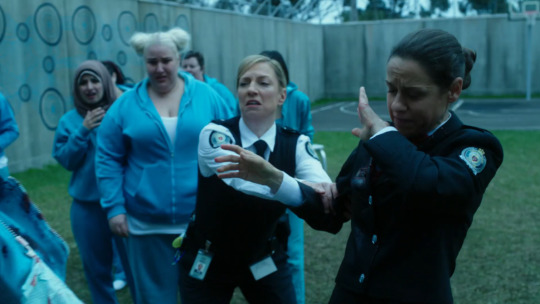




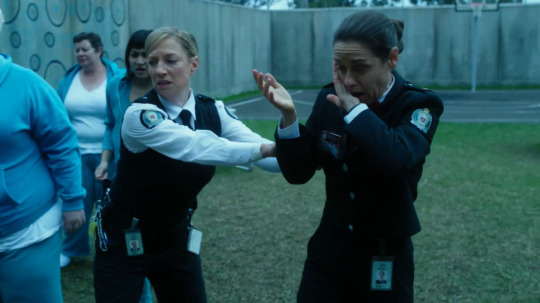

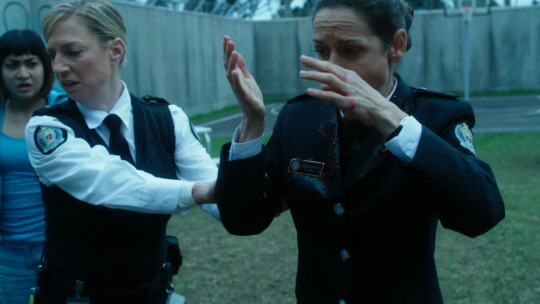
5x6 ‘Happy Birthday Vera’
1 note
·
View note
Text






Scans from AX December 1998
By 阿麒麟270
#cowboy bebop#faye valentine#katerina solensan#julia#vt#v.t.#victoria terpsichore#stella#ed#radical edward#edward wong hau pepelu tivrusky iv
28 notes
·
View notes
Text
not to alarm anyone but i'm drawing alexis at the summit rn and this is maybe gonna be the best thing i've drawn since idk the last time i drew something really good
#i'm so excited#i might even make myself do shading for this one GASP shocking i know#i just love her so much#i didn't even care for her at all until ppl being weird about not liking her radicalized me into being her#numbr 1 fan#stella's horoscope
15 notes
·
View notes
Text
COWBOY BRACKET:
PHASE 1 - ROUND 1


#waltz for venus#jamming with edward#cowboy bebop#spike spiegel#roco bonnaro#stella bonnaro#faye valentine#radical edward#radical ed#edward wong hau pepelu tivrusky iv#poll#bracket
16 notes
·
View notes
Text
In other news, this week a French publisher on his way to the London Book Fair was arrested by British counter-terrorist police to be questioned about his participation in protests in France.

A French publisher has been arrested on terror charges in London after being questioned by UK police about participating in anti-government protests in France.
Moret arrived at St Pancras [...] with his colleague Stella Magliani-Belkacem, the editorial director at the Paris-based publishing house, to be confronted by the two officers. [...] He was questioned for six hours and then arrested for alleged obstruction in refusing to disclose the passcodes to his phone and computer. [...] He was transferred to a police station in Islington, north London, where he remained in custody on Tuesday. He was later released on bail.
Éditions la Fabrique is known for publishing radical left authors. Moret also represents the French science fiction novelist Alain Damasio and had arranged more than 40 appointments at the London book fair. [...]
[Quoting publishing house’s press release] “The police officers claimed that Ernest had participated in demonstrations in France as a justification for this act – a quite remarkably inappropriate statement for a British police officer to make, and which seems to clearly indicate complicity between French and British authorities on this matter.” [...] “There’s been an increasingly repressive approach by the French government to the demonstrations, both in terms of police violence, but also in terms of a security clampdown.”
(Guardian link - BBC link) (article in French)
The publishing house (here’s their latest statement in French) and the publisher’s lawyer mention that the British police asked him “Do you support Emmanuel Macron? Did you attend protests against the pension reform?” and he was also asked to name the authors with anti-government views that his employer has published. They add, “Asking the representative of a publishing house, in the framework of counter-terrorism, about the opinions of his authors, is pushing even further the logic of political censorship and repression of dissenting thought. In a context of social protests and authoritarian escalation on the part of the French government, this aspect [of the questioning] is chilling.”
Being an accomplice to thoughtcrime by publishing dissident authors gets you treated like an international terrorist now... The publisher’s lawyer suggests that French authorities asked the UK to help them get their hands on the publisher’s contacts in the radical left sphere. But on the face of it, we’ve got: Exercise your right to protest your government in France -> get arrested by counter-terrorist UK police in London. That’s literally the reason he was given for being greeted by police at the train station...


#frpol#i bought a couple of books from la fabrique this morning... win-win i actually meant to read them and didn't know they were#published by them#in slightly better news @french people if you haven't seen some video excerpts of macron meeting alsatians today it's worth checking out#people telling him how corrupt his gov is; someone saying ''you're going to fall; mark my words'' and someone else#''we don't want your reform you arsehole'' and people chanting 'macron resign' as he walks away looking a bit pissed...#and naturally protests were banned in the cities he visited today and cops had cleared the area of actual protesters#before macron arrived so the people he met were actually the less angry people
993 notes
·
View notes
Text
Abolition For Beginners (2023 Edition)
In honor of Tyre Nichols and all others we have lost to policing and imprisonment. In honor of Black History Month. In honor of Better Future Program's mission to educate and serve marginalized youth globally... Let's break down abolition, again. (As usual on Tumblr, tap for better quality.)
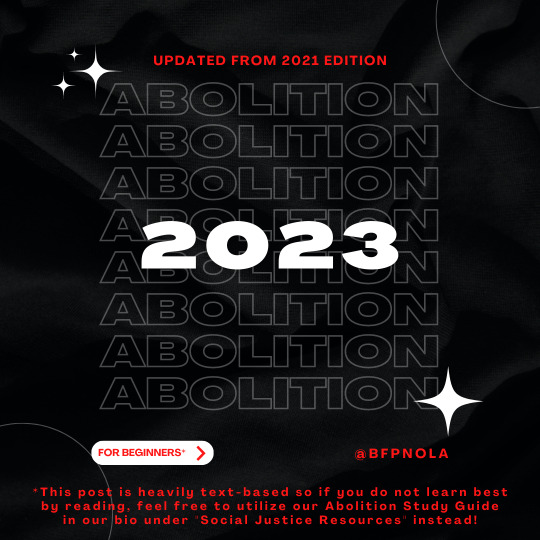
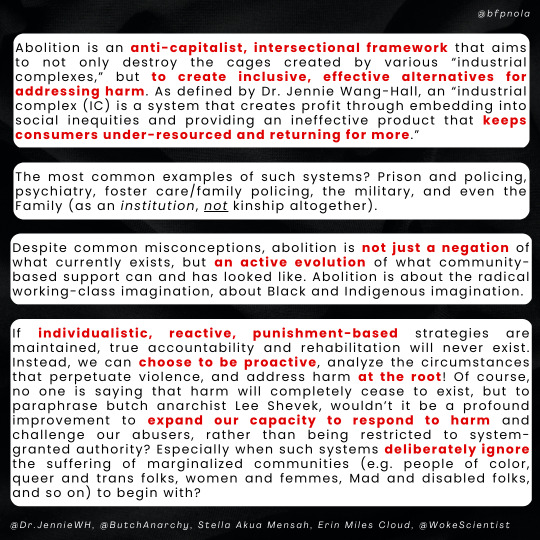

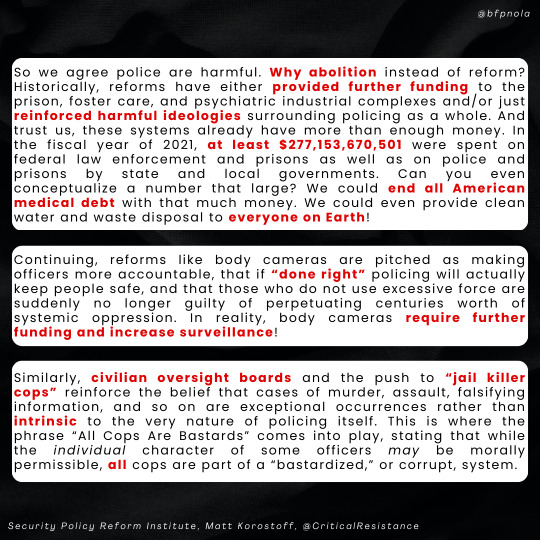
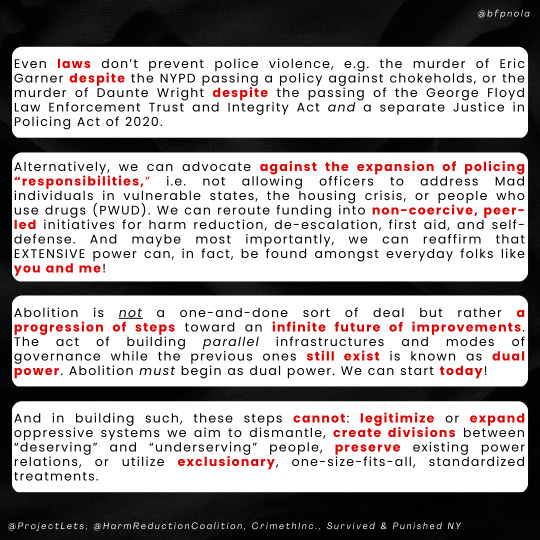


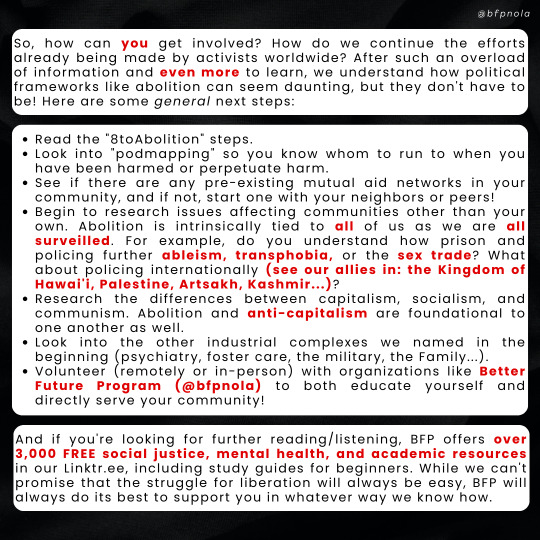
Better Future Program's Linktr.ee | Donate | Liberation Library | Open Leadership Positions | Staff Application | Discord Server
Image description below. Written by @reaux07. Proofread by the volunteers and supporters of @bfpnola.
Image Description:
[ID: All of the following slides use a wrinkled, black fabric as their background with black text (bolded red added for emphasis) on top of white boxes with rounded corners. “@bfpnola” is written in the top right corner and the sources for the slide are in the bottom left corner.
Title Slide (No. 1):
Written in red text, “UPDATED FROM 2021 EDITION.” The outlines of the word “ABOLITION” is written line by line 8 times in light grey with the year “2023” written on top in bold, white lettering. Below, written in red within a white bubble and red arrow, it reads “FOR BEGINNERS*.” Across from the bubble, “@BFPNOLA” is in red. Below, in red again, the asterisk mentioned before leads to the following note: “This post is heavily text-based so if you do not learn best by reading, feel free to utilize our Abolition Study Guide in our bio under "Social Justice Resources" instead!” Lastly, white stars and outlines of grey circles can be seen in each corner of the slide.
Slide No. 2 reads:
Abolition is an anti-capitalist, intersectional framework that aims to not only destroy the cages created by various “industrial complexes,” but to create inclusive, effective alternatives for addressing harm. As defined by Dr. Jennie Wang-Hall, an “industrial complex (IC) is a system that creates profit through embedding into social inequities and providing an ineffective product that keeps consumers under-resourced and returning for more.”
The most common examples of such systems? Prison and policing, psychiatry, foster care/family policing, the military, and even the Family (as an institution, not kinship altogether).
Despite common misconceptions, abolition is not just a negation of what currently exists, but an active evolution of what community-based support can and has looked like. Abolition is about the radical working-class imagination, about Black and Indigenous imagination.
If individualistic, reactive, punishment-based strategies are maintained, true accountability and rehabilitation will never exist. Instead, we can choose to be proactive, analyze the circumstances that perpetuate violence, and address harm at the root! Of course, no one is saying that harm will completely cease to exist, but to paraphrase butch anarchist Lee Shevek, wouldn’t it be a profound improvement to expand our capacity to respond to harm and challenge our abusers, rather than being restricted to system-granted authority? Especially when such systems deliberately ignore the suffering of marginalized communities (e.g. people of color, queer and trans folks, women and femmes, Mad and disabled folks, and so on) to begin with?
Sources: @Dr.JennieWH, @ButchAnarchy, Stella Akua Mensah, Erin Miles Cloud, @WokeScientist
Slide No. 3 reads:
Before we continue any further, let’s destroy the myth that cops actually stop violence. First off, we can’t depend on crime stats at face value because this begs the question of who exactly gets to define what counts as a “crime” and why (e.g. drug possession and sleeping in public vs. tax evasion of the wealthy and wage theft). Continuing, crime rates often only reflect violations that have actually been reported, chosen to be shown, and deemed out of line. By this logic, crime rates are simply reflections of cops’ perceptions, not of the material and emotional realities of the proletariat (i.e. the working-class).
As for perpetuating violence, “US law enforcement killed at least 1,183 people in 2022, making it the deadliest year on record for police violence.” (And those are just the deaths that were reported. In our home state of Louisiana, turns out the Jefferson Parish Sheriff’s Office, as of January 12, 2023, has been unlawfully destroying records of officer misconduct for at least 10 years.) Many (69%) of these murders were cases in which no offense was alleged, were mental health or welfare checks, or involved traffic violations and other nonviolent offenses.
This is, of course, without even touching on the involuntary servitude (i.e. enslavement) and maltreatment ongoing in American prisons. How many more deaths must occur before the general public says enough is enough? Or is this acceptable since these are working-class, disabled, Mad, non-white, queer, and trans lives being lost?
Sources: @InterruptCrim, The Guardian, Mapping Police Violence, @VeriteNewsNola
Slide No. 4 reads:
So we agree police are harmful. Why abolition instead of reform? Historically, reforms have either provided further funding to the prison, foster care, and psychiatric industrial complexes and/or just reinforced harmful ideologies surrounding policing as a whole. And trust us, these systems already have more than enough money. In the fiscal year of 2021, at least $277,153,670,501 were spent on federal law enforcement and prisons as well as on police and prisons by state and local governments. Can you even conceptualize a number that large? We could end all American medical debt with that much money. We could even provide clean water and waste disposal to everyone on Earth!
Continuing, reforms like body cameras are pitched as making officers more accountable, that if “done right” policing will actually keep people safe, and that those who do not use excessive force are suddenly no longer guilty of perpetuating centuries worth of systemic oppression. In reality, body cameras require further funding and increase surveillance!
Similarly, civilian oversight boards and the push to “jail killer cops” reinforce the belief that cases of murder, assault, falsifying information, and so on are exceptional occurrences rather than intrinsic to the very nature of policing itself. This is where the phrase “All Cops Are Bastards” comes into play, stating that while the individual character of some officers may be morally permissible, all cops are part of a “bastardized,” or corrupt, system.
Sources: Security Policy Reform Institute, Matt Korostoff, @CriticalResistance
Slide No. 5 reads:
Even laws don’t prevent police violence, e.g. the murder of Eric Garner despite the NYPD passing a policy against chokeholds, or the murder of Daunte Wright despite the passing of the George Floyd Law Enforcement Trust and Integrity Act and a separate Justice in Policing Act of 2020.
Alternatively, we can advocate against the expansion of policing “responsibilities,” i.e. not allowing officers to address Mad individuals in vulnerable states, the housing crisis, or people who use drugs (PWUD). We can reroute funding into non-coercive, peer-led initiatives for harm reduction, de-escalation, first aid, and self-defense. And maybe most importantly, we can reaffirm that EXTENSIVE power can, in fact, be found amongst everyday folks like you and me!
Abolition is not a one-and-done sort of deal but rather a progression of steps toward an infinite future of improvements. The act of building parallel infrastructures and modes of governance while the previous ones still exist is known as dual power. Abolition must begin as dual power. We can start today!
And in building such, these steps cannot: legitimize or expand oppressive systems we aim to dismantle, create divisions between “deserving” and “underserving” people, preserve existing power relations, or utilize exclusionary, one-size-fits-all, standardized treatments.
Sources: @ProjectLets, @HarmReductionCoalition, CrimethInc., Survived & Punished NY
Slide No. 6 reads:
One of the main questions brought up, though, is what abolitionists plan to do in the case of homicide, rape, domestic violence, and other harms. While this is entirely valid, this question seems to imply that 1) police are already effectively responding to such harms rather than perpetuating and/or ignoring them and 2) that there is one collective abolitionist response.
For one, the majority of sexual assault, for example, goes unreported and less than 0.5% of perpetrators are incarcerated. (And this assumes that through the reporting process and incarceration, survivors will somehow find healing, perpetrators will find understanding, and that sexual assault does not continue within prisons.) Meanwhile, let’s use our hometown as one example of many, a complaint of sexual violence is filed against a New Orleans Police Department officer every 10 days and nearly 1 in 5 NOPD officers have been reported for sexual and/or intimate partner violence.
And secondly, we have a plethora of organizations like Critical Resistance and cultures like that of the Diné (Navajo) to learn from and build upon. We don’t have to be stuck within this false dilemma fallacy, that there is only policing or total chaos. Don’t you see that that is the state’s way of constricting communal power?
Sources: @RAINN, @CopWatchNola, @WokeScientist
Slide No. 7 reads:
To expand this conversation, abolition heavily aligns with the political ideal of “anarchism.” Anarchism supports the absence of government and absolute freedom of the individual. And despite its negative connotations, anarchy also reflects an evolution of community-based care rather than just a deconstruction of what currently exists.
A simplified version of its 6 agreed-upon principles are:
Autonomy and Horizontality: define yourself on your own terms, we stand on an equal footing
Mutual Aid: bonds of solidarity form a stronger social glue than fear, support your community
Voluntary Association: associate or don't associate with whomever you wish
Direct Action: accomplish goals directly rather than depending on representatives or authorities
Revolution: overthrow those in power who enforce coercive hierarchies (ex. white supremacy)
Self-Liberation: you must be at the forefront of your own liberation, freedom must be taken
While being an abolitionist does not require alignment with anarchism, it is worth considering how the state plays such an enduring role in various social harms. Concurrently, whenever you treat other living beings with consideration and respect, come to reasonable compromise rather than coercion, and decide to share or delegate tasks, you are already living by anarchist principles.
Sources: Peter Gelderloos, David Graeber
Slide No. 8 reads:
So, how can you get involved? How do we continue the efforts already being made by activists worldwide? After such an overload of information and even more to learn, we understand how political frameworks like abolition can seem daunting, but they don't have to be! Here are some general next steps:
Read the "8toAbolition" steps.
Look into "podmapping" so you know whom to run to when you have been harmed or perpetuate harm.
See if there are any pre-existing mutual aid networks in your community, and if not, start one with your neighbors or peers!
Begin to research issues affecting communities other than your own. Abolition is intrinsically tied to all of us as we are all surveilled. For example, do you understand how prison and policing further ableism, transphobia, or the sex trade? What about policing internationally (see our allies in: the Kingdom of Hawai'i, Palestine, Artsakh, Kashmir...)?
Research the differences between capitalism, socialism, and communism. Abolition and anti-capitalism are foundational to one another as well.
Look into the other industrial complexes we named in the beginning (psychiatry, foster care, the military, the Family...).
Volunteer (remotely or in-person) with organizations like Better Future Program (@bfpnola) to both educate yourself and directly serve your community!
And if you're looking for further reading/listening, BFP offers over 3,000 FREE social justice, mental health, and academic resources in our Linktr.ee, including study guides for beginners. While we can't promise that the struggle for liberation will always be easy, BFP will always do its best to support you in whatever way we know how.
End ID.]
#reaux speaks#signal boost#tyre nichols#keenan anderson#cop city#abolition#abolish the police#defund the police#anti capitalism#intersectional feminism#palestine#black lives matter#blm#bipoc#disability justice#queer#trans#mass incarceration#study guide#mad liberation#psychiatry#family#military industrial complex#foster care#ACAB#tw rape mention#indigenous#anarchism#pinned post#BLACK HISTORY MONTH
730 notes
·
View notes
Text
Thinking some more about the futures for minor Hillerska kids on the bus this morning:
I now associate Henry strongly with his love of soccer/football thanks to @sflow-er, so I can see him rather happily owning a soccer team.
Do we have any thoughts about what line of business Nils’s parents are in? I want Nils to start his own company in a similar field as his parents but do something radically different in how he runs the business, such that it causes awkward fighting at holiday dinners. Nils’s partner works in tech or cybersecurity. Nils’s partner’s dog works in Being A Good Girl Who Deserves A Treat.
Stella gets involved in some sort of youth-empowerment work with an anti-bullying focus. Her (former) mean girl status (because she’s had like 7-10 more years to grow as a person, and this work is part of her attempt to atone) means she has helpful insight into the bullies’ mindsets.
Fredrika I imagine studying art history in university and getting pretty passionate about it actually? She has a junior curator job at a museum where her mother is a big donor; she knows it’s her mother’s donations that got her through the door and tries to hide how ambivalent she feels about that. She has perhaps grown less than Stella so far in some ways (and more in others) but her reckoning is on the way.
That’s it for the moment. Thoughts and additions always welcome!
40 notes
·
View notes
Text
Stolitz Rant
Now before I shit on the ship and Stolas' whole character, I have to give Spindle Horse some praise. Seeing Blitzo go off on Stolas was like eating your gran's food, comforting, something that you waited for, and fulfilling. Blitzo pleading like a desperate animal for the book was actually very potent, I won't get too much into my life but I have done things similar for people in my past to stay even though it was a dysfunction mess.
Alright that's my little hat's off to you Viv. Now let's get to my problem with this ship.
Unhealthy in a Bad Way
It's unhealthy. Now that inherently isn't the bad thing, now before you judge me too hard, I'll explain. If a pairing is presented as toxic that's not my issue but rather how it is handled. Stolitz isn't really presented by the show's narrative to be a horrible mess that should of died as soon as the two grew apart in their adult life. Instead it is presented like a us verses them. Romeo and Juliet type of romance. Now it doesn't really work that way because of everything that one side has done.
Stolas Sucks
I hate this fucking rich bird man, he was such good villian potential, until someone named Vivziepop got to attached to him, and tried to change the story for him to be a hopeless romantic who has a tragic home life, a damsel in distress who needs his knight in shiny armor to save him, instead of what he is a creepy rich man taking advantage of someone, and is definitely just seeing Blitzo as a toy in every since of the word.
If Stolas wants Blitzo to fuck him then it's fine because HE wants it. If HE decided that his daughter needs to be around someone who has ruined her family then she will because Stolas wants it, not even bothering to ask the man in question if he's comfortable with that arrangement. Blitzo doesn't like how he treats him, doesn't matter because Stolas likes it. HE doesn't want Blitzo to have the book anymore and Blitzo will just blindly accept it because that's what Stolas wants. This man with a child acts like a whiny little baby because the man who he has harassed, stalked, coerced into having sex with him, and treats like some kind of exotic pet, doesn't trust him when he gives him the stupid crystals because it goes against want HE wants to happen.
All of that was to point out how self serving this dumbass is.If Stolas wants it to go that way it just will because he deserves it after having an abusive wife. Now abuse is a serious subject, but it's clear as day that Stella was made to be abusive to make Stolas seem understandable. Also doesn't help that the story neglects to inform you that Stolas and Stella had Octavia at 19 and were both victims of the higher class by being forced into this marriage at like 16.
My Big Problem
Now I'll get into the whole contract to sex thing and how morally backrupt he is. This rich man knew how vital that book was for his obsession's business, to the point that he was literally stealing it from him on his birthday. Now like a reasonable man he kicked him out and never made any terrible decision ever, sadly no he fucked him and really liked it. So sometime later the bird man was in his bathtub and called his side piece, while Blitzo is in obvious distress he gives him an offer and won't shut up till he verbally agrees, which the imp did. Now what part of this is romantic? Or even sexy in a taboo way. Like what in the Wattpad is this arrangement. This feels like a ripoff of a book that just shows a toxic relationship like it's suppose to be good, Fifty Shades of Gray. A similar dynamic to our two men here weirdly enough. Which originally was a fanfiction. Now my dear reader like I said a toxic relationship in media isn't inherently bad, but if it is written badly then we have a problem. Why? you may ask me. Simple early teens watch this show, edgy kids watch this show. I personally think kids are fucking radical little guys, but they are also easily influenced. A show that paints this unhealthy relationship as good and worth all the fighting, that it is worth all the heartbreak and trauma because one day it might get better, key word might. For some viewers maybe it was their first gay relationship they were exposed to. This could shift the way they look at LGBT+ relationships as more taboo or sexy instead of it being just another relationship.
Now I'll wrap this rant up, next will be M&M relationship a d how I think it has some accidental toxic underlining, hopefully I can also get my solutions to this and M&M out today aswell.
As always you look fabulous, I'll eat your least favourite organ if you don't say something nice to yourself today. If your having a not getting out of bed day, it's alright the world is scary and you can try again tomorrow.
25 notes
·
View notes
Text
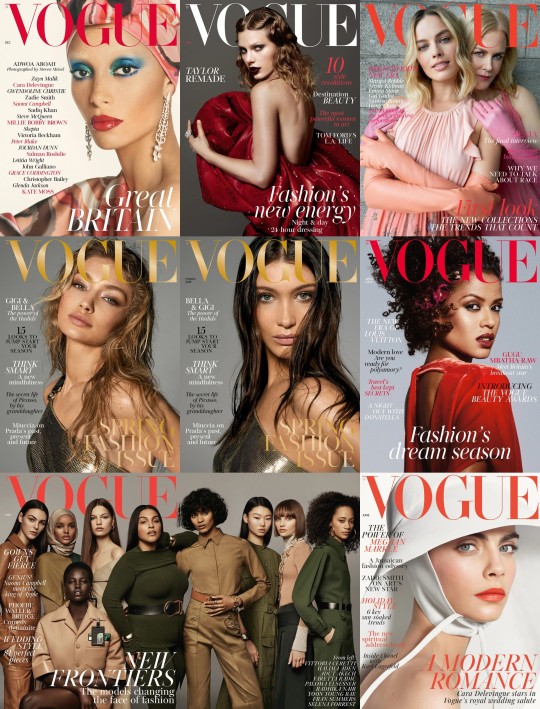

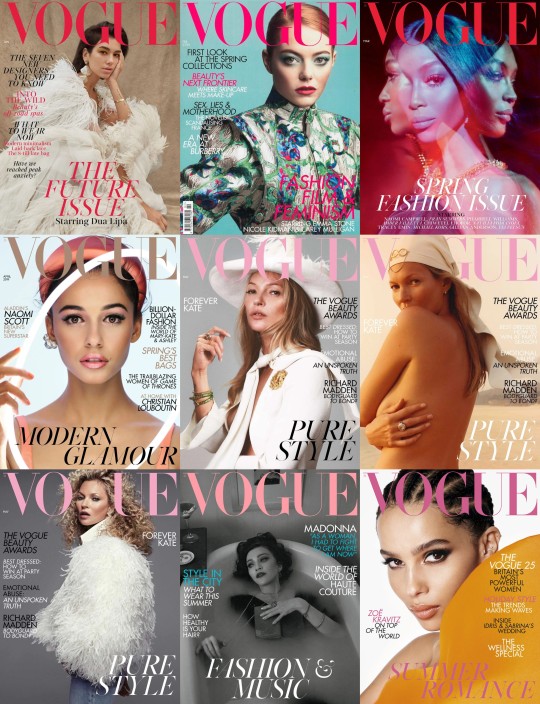

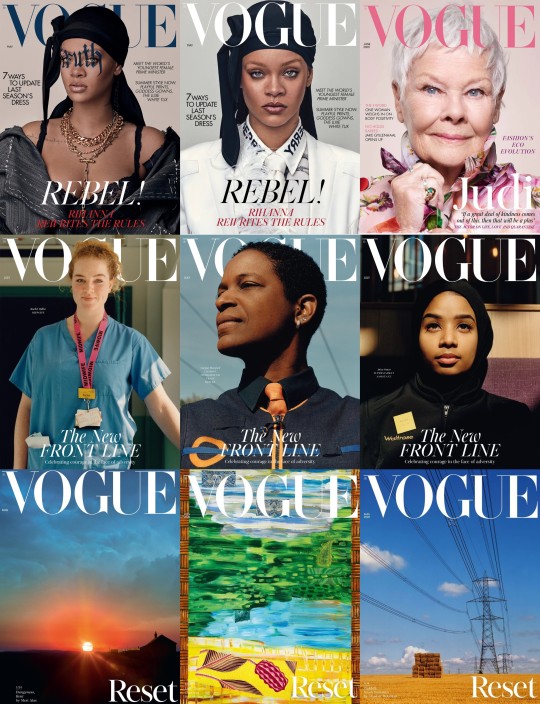

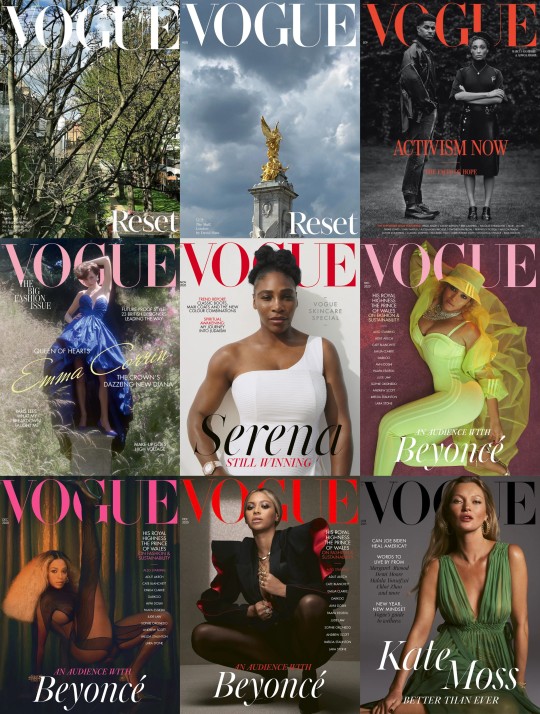

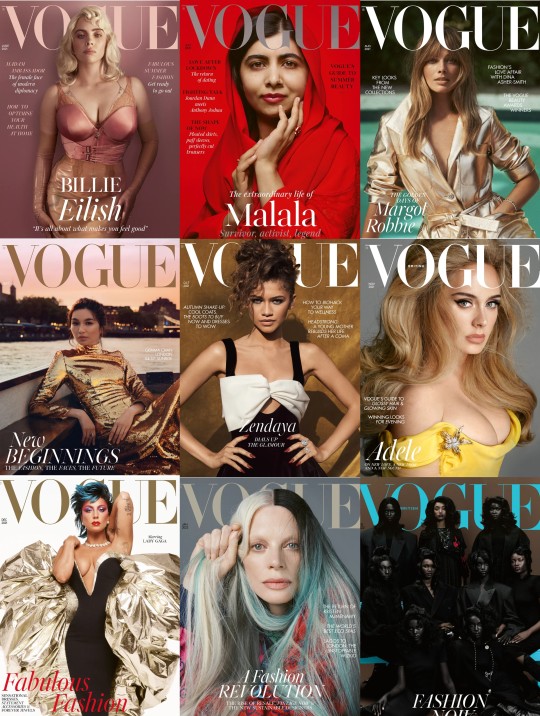

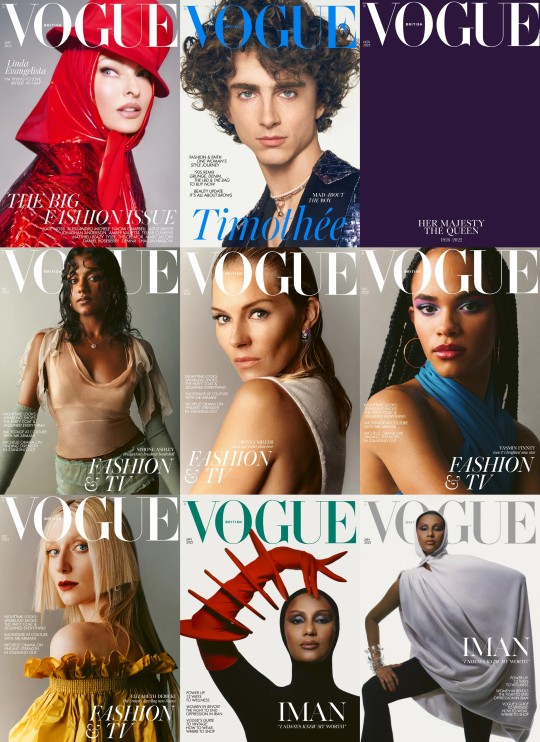
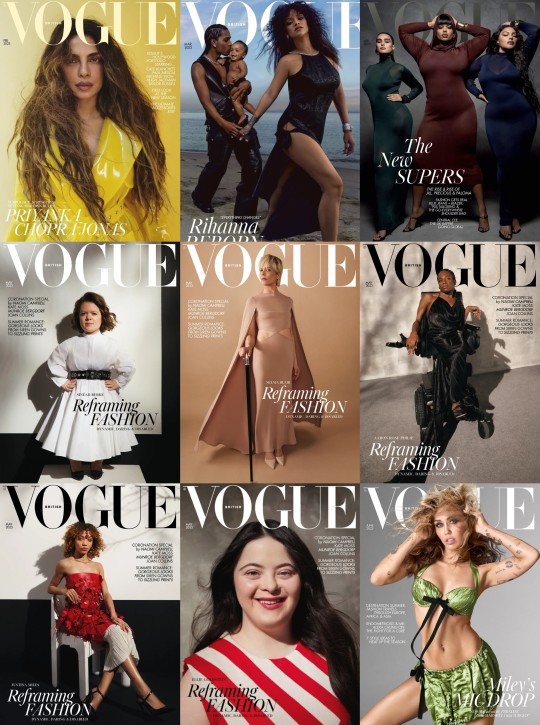

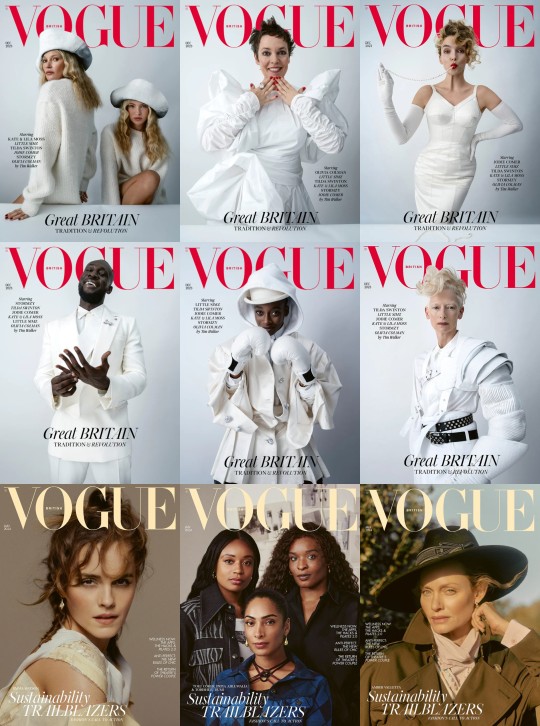
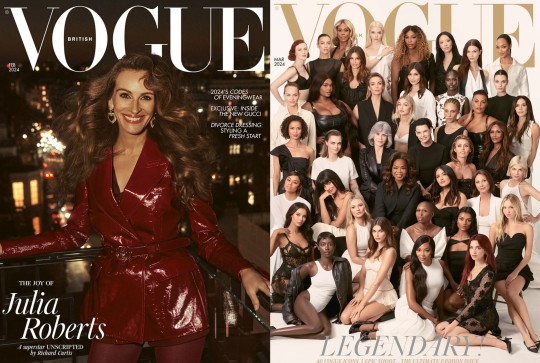
Edward Enninful's British Vogue (December 2017-March 2024)
December 2017: Adwoa Aboah by Steven Meisel
January 2018: Taylor Swift by Mert & Marcus
February 2018: Margot Robbie & Nicole Kidman by Juergen Teller
March 2018: Gigi Hadid & Bella Hadid by Steven Meisel
April 2018: Gugu Mbatha-Raw by Mikael Jansson
May 2018: Vittoria Ceretti, Halima Aden, Adut Akech, Faretta Radic, Paloma Elsesser, Radhika Nair, Yoon Young Bae, Fran Summers & Selena Forrest by Craig McDean
June 2018: Cara Delevinge by Steven Meisel
July 2018: Ariana Grande by Craig McDean
August 2018: Oprah Winfrey by Mert & Marcus
September 2018: Rihanna by Nick Knight
October 2018: The Beckham's by Mikael Jansson
November 2018: Fran Summers by Inez and Vinoodh
December 2018: Stella Tennant, Adut Akech, Primrose Archer & Saffron Vadher by Steven Meisel
January 2019: Dua Lipa by Nadine Ijewere
February 2019: Emma Stone by Craig McDean
March 2019: Naomi Campbell by Steven Meisel
April 2019: Naomi Scott by Nick Knight
May 2019: Kate Moss by Mikael Jansson, Jamie Hawkesworth & Inez & Vinoodh
June 2019: Madonna by Mert & Marcus
July 2019: Zoë Kravitz by Steven Meisel
August 2019: Karlie Kloss by Steven Meisel
September 2019: Adut Akech, Gemma Chan, Greta Thunberg, Jameela Jamil, Chimamanda Ngozi Adichie, Adwoa Aboah, Jacinda Ardern, Francesca Hayward, Ramla Ali, Christy Turlington, Salma Hayek, Sinéad Burke, Jane Fonda, Laverne Cox & Yara Shahidi by Peter Lindbergh
October 2019: Kaia Gerber by Steven Meisel
November 2019: Jourdan Dunn by Nick Knight
December 2019: Emma Watson by Alasdair McLellan
January 2020: Taylor Swift by Craig McDean
February 2020: Lupita Nyong’o by Steven Meisel
March 2020: Irina Shayk by Mert & Marcus
April 2020: Jodie Comer by Steven Meisel
May 2020: Rihanna by Steven Klein
June 2020: Judi Dench by Nick Knight
July 2020: Rachel Millar, Narguis Horsford & Anisa Omar by Jamie Hawkesworth
August 2020: Reset by Mert Alas, Lubaina Himi, Alasdair McDean, Craig McDean, Nadine Ijewere, Nick Knight, David Hockney, David Bailey, Martin Parr, Marcus Piggot, Jamie Hawkesworth, Tim Walker, Juergen Teller & David Sims
September 2020: Marcus Rashford & Adwoa Aboah by Misan Harriman
October 2020: Emma Corrin by Charlotte Wales
November 2020: Serena Williams by Zoë Ghertner
December 2020: Beyoncé by Kennedi Carter
January 2021: Kate Moss by Mert & Marcus
February 2021: Dua Lipa by Emma Summerton
March 2021: Angelina Jolie by Craig McDean
April 2021: Janaye Furman, Precious Lee, Mona Tougaard & Achenrin Madit by Steven Meisel
May 2021: Thandiwe Newton by Mikael Jansson
June 2021: Billie Eilish by Craig McDean
July 2021: Malala Yousafzai by Nick Knight
August 2021: Margot Robbie by Lachlan Bailey
September 2021: Gemma Chan by Hanna Moon
October 2021: Zendaya by Craig McDean
November 2021: Adele by Steven Meisel
December 2021: Lady Gaga by Steven Meisel
January 2022: Kristen McMenamy by Steven Meisel
February 2022: Amar Akway, Majesty Amare, Akon Changkou, Nyagua Ruea, Abény Nhial, Maty Fall, Janet Jumbo, Adut Akech & Anok Yai by Rafael Pavarotti
March 2022: Naomi Campbell by Steven Meisel
April 2022: Anya Taylor-Joy by Craig McDean & Queen Elizabeth ll by Antony Armstrong-Jones
May 2022: Lila Moss by Steven Meisel
June 2022: Gisele Bündchen by Steven Meisel
July 2022: Beyoncé by Rafael Pavarotti
August 2022: Cara Delevingne, Cynthia Erivo, Ariana DeBose, Jordan Barrett & Munroe Bergdorf by Mert & Marcus
September 2022: Linda Evangelista by Steven Meisel
October 2022: Timothée Chalamet by Steven Meisel
November 2022: Her Majesty Queen Elizabeth II Tribute
December 2022: Simone Ashley, Senna Miller, Yasmin Finney & Elizabeth Debicki by Scot Trindle
January 2023: Iman by Nadine Ijewere
February 2023: Priyanka Chopra Jonas by Zoë Ghertner
March 2023: Rihanna, A$AP Rocky & son by Inez & Vinoodh
April 2023: Jill Kortleve, Precious Lee & Paloma Elsesser by Inez & Vinoodh
May 2023: Sinéad Burke, Selma Blair, Aaron Rose Philip, Justina Miles & Ellie Goldstein by Adama Jalloh
June 2023: Miley Cyrus by Steven Meisel
July 2023: Miriam Margolyes, Janelle Monae & Rina Sawayama by Tim Walker
August 2023: Maya Jama by Steven Meisel
September 2023: Linda Evangelista, Naomi Campbell, Cindy Crawford & Christy Turlington by Rafael Pavarotti
October 2023: Lily Gladstone & Leonardo DiCaprio by Craig McDean
November 2023: Emily Ratajokwski, Adwoa Aboah , Irina Shayk, Adut Akech, Karen Elson & Mona Tougaard by Sean Thomas
December 2023: Kate Moss,Lila Moss, Olivia Colman, Jodie Comer, Stormzy, Little Simz & Tilda Swinton by Tim Walker
January 2024: Emma Watson, Tolu Coker, Priya Ahluwalia Torishéju Dumi & Amber Valletta by Charlote Wales
February 2024: Julia Roberts by Lachlan Bailey
March 2024: Karen Elson, Irina Shayk, Laverne Cox, Anya Taylor-Joy, Serena Williams, Rina Sawayama, Karlie Kloss, Jourdan Dunn, Amber Valletta, Precious Lee, Cindy Crawford, Jodie Comer, Gemma Chan, Adut Akech, Vittoria Ceretti, Gugu Mbatha-Raw, Cara Delevingne, Jane Fonda, Gigi Hadid, Linda Evangelista, Adwoa Aboah, Miley Cyrus, Paloma Elsesser, Iman, Victoria Beckham, Ariana DeBose, Jameela Jamil, Oprah Winfrey, Salma Hayek, Christy Turlington, Selma Blair, Maya Jama, Anok Yai, Kate Moss, Kaia Gerber, Cynthia Erivo, Naomi Campbell, Simone Ashley, Dua Lip & Lila Moss by Steven Meisel
45 notes
·
View notes
Note
I'm so interested in all of your posts about mad liberation. I've never seen anything that puts my thoughts on the whole psych complex into words. I'm really curious to learn more about this. No pressure if not, but do you happen to know of any more comprehensive resources on this? Like books maybe?
Hi, I can definitely give you some recs! My list is a little bit UK centric because that's where I'm based but hopefully it's useful:
In terms of books:
I read 'Mad World: The Politics of Mental Health' by Micha Frazer-Carroll this summer and I can't recommend it enough.
I'm also making my way through 'Call Me Crazy: Stories from the Mad Movement' by Irit Shimrat, which I think is out of print but can be read as a PDF here (hopefully)
I've only dipped in and out of his books for my dissertation but Andrew Scull has written several well regarded books about the history of psychiatry ('Museums of Madness' is the one I've read bits of, 'Desperate Remedies' is on my TBR)
Some books on my TBR: 'The Protest Psychosis: How Schizophrenia Became a Black Disease' by Johnathan Metzl, 'Drop the Disorder!', 'Searching for a Rose Garden: Challenging Psychiatry, Fostering Mad Studies', 'Anatomy of an Epidemic' by Robert Whitaker
Some really good articles:
'Abolition Must Include Psychiatry' by Stella Akua Mensah
'Mad Activists: The Language We Use Reflects Our Desire for Change' by Lisa Archibold
'Not a naughty child: people’s experiences of service responses to self-injury' by Alison Faulkner and Rachel Rowan Olive
More resources!
The Campaign for Psychiatric Abolition - UK based, they have a lot of really great resources including an extensive recommended reading list, a Psych Abolition 101 Zine, and a resource for making a crisis support plan.
Asylum Magazine - again UK based, radical mental health magazine. To read full issues you need to subscribe (I recently paid for a subscription for a year of digital editions for £10, physical copies are a bit more) but the website has plenty of articles that you can read for free so well worth exploring.
Psych Survivor Archive - US based this time, there is so much on here, the Psych Survivor Zine is the main event but they also have a really great resource list (some of the links are dead though).
Mad in America - publish a lot of really interesting and impactful stuff on their website, I also really like their podcast (particularly recommend this episode about ECT, this one about esketamine, and this one about 'prolonged grief disorder'). There is also Mad in the UK and a number of other country specific sites that exist as part of their Mad in the World Network.
Folks to follow:
Dolly Sen - UK based artist who does and is doing a lot of cool stuff, notably at the moment they are the lead artist for the Birdsong From Inobservable Worlds project. This podcast episode they did is also great.
Nicole / lacey_art_ - another UK based artist, she wrote a poem about a bird recently that I can't stop thinking about (she does a lot of other cool things too).
Rachel Rowan Olive - brilliant and funny artist, she is also on instagram and etsy.
Luna Tic - artist and activist who has been involved with a lot of really brilliant stuff, including the successful StopSIM Coalition here in the UK which managed to bring an end to SIM.
There are so many more I could name and so many more things I could recommend but this post is already so long! I really hope it was helpful. I started trying to be brief and then gave up but I did cut out a fiction and literature recs section because I thought that was overkill lmao. Thank you for giving me an excuse to make this list I had a great time.
Learning about the Mad and psych survivor movements has been so transformative and empowering for me and I could honestly talk about it all day. Please do feel free to send me a message if you want to chat about it more!
#mad liberation#psych abolition#psych abuse#anti psych#psychiatry#psychiatric survivor#mad pride#madness#reading recs#long post
26 notes
·
View notes
Text
I battuti

Scrive l'autore nella sua prefazione:
If any city in American deserves the title of home of the Beat Generation, it is San Francisco. Although New York can rightly boast to be the birthplace of the Beats, the literary group came to maturity and national prominence in this most beautiful city by the bay. In the 1950s San Francisco was a magnet attracting inventive writers, artists, and thinkers during the conservative postwar years. Intellectual freedom blossomed with the publication and trial of “Howl” and by the 1960s, San Francisco was the destination of choice for a new generation of radical innovators.
La foto di copertina, di Larry Keenan, scattata davanti al City Lights Bookstore, è del 1965 e comparve anche sulla copertina del numero tre del City Lights Journal che uscì con data 1° gennaio 1966.
Lawrence (aka Lorenzo) Ferlinghetti voleva documentare la scena Beat di San Francisco con lo stesso spirito delle classiche foto degli artisti e scrittori bohémien di Parigi agli inizi del '900.
I Beat: fila in basso da sinistra a destra: Robert LaVigne, Shig Murao, Larry Fagin, Leland Meyezove (sdraiato), Lew Welch, Peter Orlovsky.
Seconda fila: David Meltzer, Michael McClure, Allen Ginsberg, Daniel Langton, Steve (?), Richard Brautigan, Gary Goodrow (a metà).
Dietro: Stella Levy e Lawrence Ferlinghetti che col suo ombrello della casa editrice City Lights Books protegge tutto il gruppo.
B. Morgan, The beat generation in San Francisco. A literary tour, San Francisco, City Lights Books, 2003
11 notes
·
View notes
Text
reasons you should play scarlet hollow
SCARLET HOLLOW is a horror narrative game set in the dying north carolina coal mining town of Scarlet Hollow, where you play the cousin of tabitha scarlet (head of the mines), coming back to town after a family rift for your aunt's funeral. things are wrong in town, and as tensions simmer over working conditions in the mine, the dark secrets of the town start to boil over in the form of supernatural events. work with cryptid hunter stella, general store owner kaneeka and her witchy mother sybil, newcomer avery, hot dad librarian oscar, mysterious artist reese, and of course, your cousin tabitha to uncover the secrets of scarlet hollow--before they drag you and your friends into the depths.
WHY YOU SHOULD PLAY:
there are seven character traits to choose from (mystic, talks to animals, hot, street smart, powerful build, keen eye, and booksmart). you pick two, and they influence how you can react to situations and how people can react to you. i've done three playthroughs with different traits so far, and they have all been radically different. the second playthrough i did, i was blown away by how many things were fixable, or could be made so very much worse, or hadn't existed at all in my first playthrough.
going off of that: the choices that you make in this game actually matter. and not in a "you can have different buddies going into the final battle!" sort of way. in a life or death sort of way, in a brutal consequences for our heroes sort of way. there is at least one MAJOR decision in each chapter, which can end in multiple different ways depending on your choices, and they stick with you.
the characters have rich back stories, and you can tell that the writers planned this whole story out from start to finish before releasing chapter one. i just started a playthrough after finishing chapter four, and the events of that chapter are foreshadowed all over the place in ch1, which was released a year ago.
it's GENUINELY scary without relying on cheap jumpscares or gore tactics. so much of the horror in this game comes from the dread it invokes, and the implications for our heroes. in chapter four, i was literally hiding behind my hands for a large section of the game.
i need PEOPLE TO TALK TO ABOUT THIS GAME because i am LOSING MY MIND over how good and game-altering chapter four was, and i am gonna die. thank you please do the damn thing
283 notes
·
View notes
Text
Deep dive wondering about Sara's backstory (CW: drug / alcohol abuse) (Part 2)
CW Drug & Alcohol abuse by a parent
This is part 2 of a post about trying to figure out Sara's motivations and actions and how they are influenced by being raised in a home with a drug/alcohol dependent parent. Feedback / thoughts very much welcome.
Watching: Frida Argento is an incredible actor, and people often talk about how expressive she is with her eyes. This is partly her, and partly her character: Sara sees EVERYTHING. There are numerous points in the story line where it is literally only us, the viewer, and Sara, who know everything. She sees August upload the video, she sees Stella’s crush on Fredrika, she sees Wille hold Simon’s little finger in the movie theatre, she sees through Simon’s smile the morning after when they’re waiting for class to start. The only thing she doesn’t know in the gun scene at the end of S2 is that Simon gave August the drugs to sell. I could go on. She is -literally- the eyes on this world. And she says almost nothing, until she decides to confront someone (i.e. asking Stella about her crush / asking Simon why he didn’t sleep at home). This is a kind of vigilance you learn when your home is unstable and unpredictable. You learn to watch everyone for clues as to What Is Really Going On Here, so that you might have some hope of anticipating when all hell will break loose. People with drug and alcohol problems are sober a lot of the time, and they might even have various modes of being drunk or high. You learn to put a lot of store in feeling you might be able to predict when the mood will change. If you’re a kid, trying to read these signs gives you a feeling of power in a situation where you are utterly powerless. Everything - the way someone’s lips narrow, a clench of the jaw, the music they’re playing, anything - it becomes a possible sign of the atmosphere being about the change for the worse. Vigilance becomes a way of trying to experience safety. And for Sara, the fact that she does see so much ends up giving her a trump card - the ability to turn August in - in other words, the power she never had at home to finally do something about the bad actor.
Attachment: Sara was bullied at Marieberg. She knows she’s different, and she believes people don’t like her. When Felice does allow her into this secret garden called friendship, she is elated, but also insecure. For example, she gets worried when Felice and Wille become closer in S2, and asks Felice to reassure her about whether they are ‘besties’ still, and Felice says, oh you silly goose, a person can have more than one bestie. But for Sara, the love she shares with others feels intrinsically insecure and conditional: as in, people love her because of a certain tacit deal they’ve struck. This is why she is not just angry when Felice condones selling Rousseau - she is far deeply hurt, it is a betrayal of the highest order, she says she doesn’t even know who Felice is really. It all suggests a world where Sara didn’t experience love as unconditional - instead it was transactional. It’s the kind of backwards-emotional-math that kids can do to try to explain a situation that hurts but is the only thing you know — Dad is drunk again today, it must be something I did wrong; Dad is not drunk today, it must be something I did right; if Dad is drunk he’s not really him and he can’t love me as a parent; ergo, my behavior is the token that gets exchanged back and forth between us that can turn love on or off. Love is never there all the time, it can be withheld based on conduct, and people can be so radically not themselves that it makes the love they profess fake.
Her relationship with August: I think Sara unconsciously falls for August because he is a copy of her father, and she is using him to work out the trauma and disempowerment of growing up with Micke. August is a better version of Micke and, even better, one Sara believes she can control and help. As an additional extra-credit, it turns out he really loves her - in his fucked up way - which is more than Sara believes about her own father. Like Micke, August is drug-dependent. But unlike Micke, he seems to be successful and, until she gets to know him, he seems to have his shit together. It seems like he is powerful: after all, he gets her what she wants - a place at Manor House. Sara is initially uncomfortable about the pills - she confronts August about it. But then August assures her that it’s “only when he needs to perform” and that’s probably all she dreamt of hearing from her father when she was a child. August is the fairy tale prince: an addict who in fact has it under control, an addict who can actually love her. And unlike her father, he is an addict she can help (overcoming a lifetime of powerlessness for her). In fact, the thing that actually kickstarts their relationship is her getting off (literally) on the high of being able to help August when he was having a panic attack. Then, when everything goes overboard, she explains her actions in the way she learned at home: she says she was in love, and she didn’t really know what she was doing, she was not in her right mind … she was, in other words, … drunk / high … but on love. And this explanation is somehow a mitigation for her actions. She can’t be blamed for something she can’t control - which most addicts believe at some point.
#sara eriksson#simon eriksson#young royals#young royals analysis#micke eriksson#alcohol abuse#substance abuse
35 notes
·
View notes
Note
I don't know about you but I can never get pass the whole the "seven deadly sins contradictions with what they represents"
Reason why I say that because the whole point of the 7DS is to avoid doing what is considered a sin. A demon believing in conset or avoid overconsumption is like a war but without all the dead and fighting but instead they just have pillow fights.
Don't get me wrong you get the radical kind when interpretation them such as "No sex or alcohol" by this post summarize how people SHOULD interpret the 7DS
https://www.reddit.com/r/tumblr/comments/i0fse4/the_true_deadly_sins/
If you a better example of the 7DS who represents their sins but don't contradict themselves there is a game called Obey Me where the male interests are all fallen angels turned demons shows the sins they represents.
Ah ok.
Yeah the seven deadly sins in Helluva Boss are so downgraded its so insulting and goes to show just how much Viv doesnt want to see her ocs as "bad people" despite them clearly being so.
She keeps hiding the bad things her characters do behind a curtain or laughs at their bad behavior outside of MAYBE Valentino and Stella. But that's it!
It's such a downgrade from other demon shows smh.
9 notes
·
View notes
Text
Little rant about the Etoiles Noires and gender ahead (i need to get the starmania brainrot out of my system and can not stop analyzing everything i watch through a queer lens)
i can't quite articulate how much i love the 2022 version of Starmania but one of my fav bits is at the end of travesti, after sadia's just sung about being hot and fucking crazy and Not Cis™, and after killing like 3 different people in the span of one song, all of the étoiles noires (which are mostly men here) gather around the car and sing with her !!! like. they know, they don't care, and they think it slays.
the fact that those murders happens during travesti makes the queer narrative more obvious because, of course, it's all about transgression. the étoiles noires are those left behind by society, those who don't "fit in" an expected norm, so they embrace what makes them different and they find community in violence. sadia (who is literally the allegory of that violence) embodies that !! the whole group singing the word "travesti" while in the middle of organized crime to overthrow the system is a political statement (and it would have been even more radical back in 1979, though idk how the song was staged). the things that makes them outcasts and their anger feeling left out are their fuel to act.
of course their respective reasons to join the zonards/étoiles noires must be different but queerness (and more generally, non-conformity to social norms) is definitely a part of it. the fact that sadia is not the one singing "des gars qui se maquillent" in 2022 confirms it, and although the étoiles noires have this "manly" behavior (which the women share anyways), they also somewhat subvert the norm, wearing make up and nail polish, showing emotions... btw i think it's good that the 2022 show goes back to a sensitive, vulnerable, somewhat feminine portrayal of johnny (which Balavoine definitely had and that was kind of lost in the 1988/1993 versions). i also really love how there seems to be a real spirit of camaraderie/friendship between them all ?? like there are displays of affection, (cf. johnny with the guy that helps him put the white coat on + the person sitting on the car next to him). they're literally commiting heinous murders but all you can see is how much fun they're having !!
then there's also the "besoin d'amour" bit which is really great because just like in travesti (the parallel in the choreography is very obvious !), they have cristal, aka stereotypical barbie, singing this girly, very much france gall-esque, pop song on the top of the car, about how joyous and fun it is to be in love, and the whole gang is dancing around her like a chorus to highlight how universal the message is.
and then cristal's transformation after joining the étoiles noires !! it's clear to me that what the media depict as a "kidnapping" is actually a sort of liberation for her: she's allowed to leave behind her perfect image (= the golden cage stella never escapes) and maybe even a part of performative femininity as shown through her outfits. (i have a short post about that coming soon!) to become this more "messy", darker version of herself that doesn't need to be pure as crystal (lol) all the time.
overall the way the étoiles noires are portrayed is really cool because it subverts the classic representation of that scary gang with cold, judgmental, unfeeling vibes, and instead makes them a supportive group that faces together a cold, judgmental, unfeeling society !
(however !!! the different periods (1979/2022/whatever year starmania takes place in) overlapping in starmania do create a dissonance in how queerness is portrayed, and of course queercoding villains is a little problematic, but that's a post for another day!)
so yeah this violent group (of outcasts) terrorizing the population being made of gnc characters that aren't afraid to show feelings means a lot to me that's it 🫶🫶🫶
#sorry this was chaotic#the ideas this gave me !!#i know sadia being an “outcast” is debatable#but i'll tackle it in my next post#still shadowbanned though !#thomas jolly#lgbtq#sadia#johnny rockfort#starmania 1979#queer analysis#queer representation#gender noncomformity#côme#gabrielle lapointe#lilya adad#manet miriam baghdassarian#ambriel#william cloutier#starmania 2022#starmania#my post
25 notes
·
View notes
Text
I found the idea that three black people would need a history lesson from a white psychiatrist (especially the two elders) on how medical racism in psychiatry worked to be kind of offensive.
Stella checking Kevin and calling out the bullshit, especially the idea that any black radical/activist was "mistakenly" targeted in that era, was the only highlight of those scenes.
Marshall being given the "as a wronged black person I must forgive the person who harmed me cause GOD" standard speech was the low point. I guess I should appreciate the attempt, but it would have hit harder if they had done it in the moment Marshall's misdiagnosis was revealed.
8 notes
·
View notes